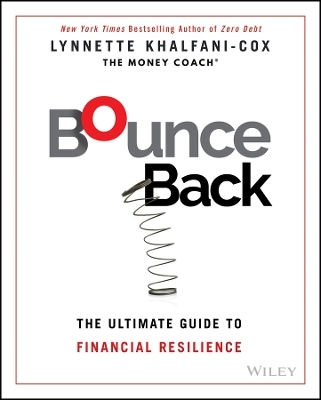
Bounce Back
John Wiley & Sons Inc (Verlag)
978-1-394-20516-5 (ISBN)
Emphasizing the critical importance of emotional, financial, social, and physical resilience, Bounce Back demonstrates 10 practical and hands-on techniques you can implement immediately to build your resilience and recover fiscally and emotionally from the most frequently experienced personal finance setbacks. You’ll also discover:
How to handle the ever-rising cost of living and the increased impact of high levels of inflation
Actionable strategies for burning down your debt as fast as reasonably possible
Practical advice for people who face discrimination and maltreatment in the financial, housing, and employment markets
An essential and endlessly inspiring roadmap to a better financial tomorrow, Bounce Back is an expert guide to transforming a seemingly impossible challenge into a manageable setback you can overcome with skill, faith, and resilience.
LYNNETTE KHALFANI-COX is a personal finance expert, keynote speaker, and the widely read author of 16 money-management books, including the New York Times bestseller Zero Debt: The Ultimate Guide to Financial Freedom. She’s a former financial news journalist and co-owner of TheMoneyCoach.net LLC, a financial education company that offers financial education consulting, financial workshops, training programs, and more.
Acknowledgments xxi
About the Author xxiii
Foreword xxv
Introduction xxvii
Chapter 1: Resilience and Grit in the Face of Adversity, Transition, and Change 1
The Drive: A Famous Sports Comeback 2
Understanding the Value of Transition and Change 3
The Upside of Your Transition and Stress 5
Defining and Developing Resilience 7
Financial Resilience 9
Structural Inequality and Systems 10
Many Forms of Resilience 13
Building Emotional Resilience 13
Write a Letter to Yourself from the Perspective of a Compassionate Friend 13
Find a Quiet, Comfortable Place to Write 13
Begin with a Friendly Salutation 14
Acknowledge Your Feelings and Struggles 14
Express Understanding and Empathy 14
Offer Support and Encouragement 14
Share Practical Advice or Coping Strategies 14
Close the Letter with Kindness and Affirmation 14
Fostering Social Resilience 15
Enhancing Physical Resilience 15
Recognizing and Embracing Your Strengths 16
Resources for Resilience and Grit 18
Chapter 2: Building Your Resilience 19
Strategy 1: Practicing Mindfulness 19
Strategy 2: Cultivating Gratitude 20
Strategy 3: Journaling 21
Strategy 4: Being Patient with Yourself 22
Strategy 5: Practicing Self-compassion 22
Strategy 6: Seeking Professional Help 24
Identify the Right Professional for Your Needs 24
Consider Different Therapy Styles and Techniques 24
Leverage Online Resources and Support Groups 24
Keep an Open Mind and Be Patient 25
Strategy 7: Staying Connected 25
Reach Out to Friends and Family 25
Join Support Groups or Clubs 25
Engage in Community Activities 26
Create a Support Network 26
Strategy 8: Focusing on Self-care 26
Maintain a Balanced Diet 26
Stay Hydrated 26
Get Regular Checkups 27
Stretch and Move 27
Prioritize Personal Hygiene 27
Limit Screen Time 27
Manage Stress 28
Exercise Regularly 28
Get Plenty of Sleep 28
Listen to Your Body 28
Strategy 9: Establishing a New Money Game Plan 29
Assess Your Current Financial Situation 29
Create a Monthly Budget 29
Set Financial Goals 30
Regularly Check Your Net Worth 30
Seek Professional Guidance 30
Stay Proactive and Adaptable 30
Maintain Open Communication with Loved Ones 31
Strategy 10: Creating a Financial Plan B 31
Identify Potential Risks and Setbacks 31
Evaluate Your Emergency Fund 32
Review Your Insurance Coverage 32
Diversify Your Income Streams 32
Create a Plan for Each Scenario 32
Maintain a Flexible Budget 33
Keep your Skills Up to Date 33
Review and Update Your Plan Regularly 33
Resources for Building Resilience 34
Chapter 3: Downsized from a Job 35
The Handwriting on the Wall 36
Downsizing and Layoffs Are Painful— and Widespread— in America 37
The Rise of AI Will Lead to More Job Loss 37
The Emotional Aspects of Job Loss 39
The Psychological Contract 39
Coping Strategies to Help 41
Being Patient with Yourself 41
Practicing Self-compassion 41
Seeking Professional Help 42
Staying Connected to Others 42
Prioritizing Self-care 42
Three Crucial Financial Steps in the Wake of Job Loss 43
Review and Adjust Your Budget 43
Apply for Unemployment Benefits 43
Build or Maintain an Emergency Fund 43
Interim Economic Moves to Survive a Downsizing 44
Explore Freelance or Gig Work 44
Consider Temporary or Part-time Employment 44
Investigate Government Assistance Programs 44
Consider Refinancing or Consolidating Debt 45
Tap into Savings Cautiously 45
Negotiate with Creditors 45
Seek Professional Financial Guidance 45
Job Hunting the Right Way 46
10 Best Career Reentry Strategies to Find New Employment 47
Reflect, Analyze, and Improve Your Way to a New Job 47
Update Your Résumé and LinkedIn Profile 48
Network the Right Way 49
Enhance Your Skills 49
Practice Your Interview Skills 49
Set Daily Job Search Goals 50
Create a Job Search Plan 50
Use Job Search Engines and Online Resources 50
Attend Job Fairs and Networking Events 50
Leverage Social Media 50
Stay Persistent and Positive 50
Should You Look for Another Job at All? 51
A Pivotal Turning Point 52
Is Entrepreneurship Right for You? 53
Downsized from a Job Resources 55
Chapter 4: Divorce 57
The Financial Cost of My Divorce 59
Women Pay Alimony and Child Support Too 60
Casting Off Your Ex-spouse Financially 61
Step 1. Close Joint Accounts 62
Step 2. Update Beneficiaries and Estate Planning Documents 62
Step 3. Change Your Name If Applicable and If Desired 64
Step 4. Establish a New Budget 66
Step 5: Reevaluate Your Insurance Needs 66
Protecting Your Credit During Divorce 67
Long-term Planning During Divorce 69
Common Financial Mistakes to Avoid During Divorce 70
Not Understanding Your Financial Situation 71
Overlooking Tax Implications 71
Failing to Update Your Estate Plan 71
Keeping the Family Home Without Considering the Costs 71
Not Considering the Long-term Impact of Asset Division 71
Ignoring Insurance Needs 71
Not Securing Spousal and Child Support Payments 72
Failing to Establish Individual Credit 72
Making Emotional Decisions 72
Not Seeking Professional Help 72
Post-divorce Stories of Emotional Recovery 72
My Sister’s Divorce Story 74
Divorce Resources 75
Chapter 5: Death of a Loved One 77
Lives Forever Changed 78
The Road to Recovery 79
Bouncing Back Amid the Pain 80
Coping Strategies to Deal with Grief 81
The Six Transition Truths 82
Transition Truth No. 1 82
Transition Truth No. 2 82
Transition Truths 3–6 83
The Trauma of Losing My Sister 83
Understanding Your Ancillary Losses 84
Emotional Support 85
Financial Stability 85
Roles and Responsibilities 85
Social Connections 85
Shared Dreams and Plans 86
Sense of Self 86
Familiar Routines 86
Taking the First Crucial Five Steps 86
Step 1: Give Yourself Time to Grieve 87
Step 2: Locate and Organize Important Documents 87
Start with the Obvious Places 88
Reach Out to Professionals 88
Request Duplicates If Needed 88
Create a Filing System 88
Keep a Master List 89
Update Your Records Regularly 89
Step 3: Inform Relevant Parties and Institutions 89
Obtain Multiple Copies of the Death Certificate 90
Make a List of Organizations to Contact 90
Prioritize Your Notifications 90
Keep Track of Your Communications 91
Be Prepared to Provide the Necessary Information 91
Seek Professional Assistance If Needed 91
Step 4: Assess Your Financial Situation 91
Make an Inventory of Assets 92
Identify Debts and Ongoing Expenses 92
Determine Sources of Income and Financial Support 92
Consult with Professionals 92
Understand Your Legal Responsibilities 92
Step 5: Create a New Budget and Financial Plan 93
Determine Your New Income and Expenses 94
Create a Detailed Budget 94
Make Necessary Adjustments 94
Build an Emergency Fund 94
Reevaluate Your Financial Goals 95
Seek Professional Guidance 95
Handling Special Circumstances 96
Loss of Household Income 96
Reduction in Social Security Benefits 96
Change in Tax Status 96
Loss of Access to Credit Cards 96
Delayed or Blocked Access to Savings and Investments 97
Inheritance Complications in Second Marriages 97
Finding Missing Money 97
Gather Important Documents 97
Contact Insurance Companies 98
Search for Bank and Investment Accounts 98
Investigate Unclaimed Property 98
Check for Retirement Accounts and Pension Benefits 98
Review Tax Records 98
Consult with Professionals 99
Making It Past the Initial Phase 99
Financial Grief Explained 99
Emotional Responses to Financial Grief 100
Death of a Loved One Resources 101
Chapter 6: Disability 103
Setting the Bar Higher 105
What Are Disabilities and How Prevalent Are They? 106
A Comprehensive View of Managing the Challenges Tied to Disabilities 107
The Basics of Disability Insurance and How It Can Help Financially 109
What Is Disability Insurance? 109
Benefits of Disability Insurance 110
All About Social Security Disability Insurance 111
Eligibility for SSDI 112
A Profile of Who Collects SSDI 112
A Host of Benefits with SSDI 113
Claiming Social Security Disability Income or Workers’ Comp Benefits 114
Getting Workers’ Compensation Benefits 115
What to Do If You Get Sued for Overpayment of Disability Benefits 116
Don’t Ignore the Situation 116
Gather Documentation 116
Contact an Attorney 117
Communicate with the Insurance Company or SSA 117
Consider Possible Defenses 117
Prepare for Court (If Necessary) 118
Six Alternative Income Sources When You Have a Disability and Can’t Work 118
Government Benefits 118
Disability Insurance 119
Personal Savings and Investments 119
Passive Income 120
Support from Family and Friends 120
Reverse Mortgages 120
Safeguarding Your Earnings During a Disability 121
Federal and State Resources That Help the Disabled and Their Caregivers 122
Financial Assistance 122
Health Care Resources 122
Housing Assistance 123
Employment Support 123
Educational Support 124
Transportation and Mobility Resources 124
Support for Caregivers 124
The Mind-Body Connections That Can Help You Overcome a Physical Disability 125
Embrace a Positive Mindset 125
Practice Mindfulness and Meditation 125
Engage in Regular Physical Activity 126
Seek Social Support 126
Utilize Therapy and Counseling 126
Consider Complementary and Alternative Therapies 126
Develop Adaptive Strategies 126
Foster a Sense of Purpose 127
Bouncing Back from Disability 127
Disability Resources 127
Chapter 7: Disease 129
Disease Can Spark a Cascade of Medical Bills 132
How to Handle Lost Income and Employment Challenges 134
Assessing Your Work Abilities and Limitations 135
Exploring Workplace Accommodations and Flexibility 135
Seeking Vocational Rehabilitation and Career Transition Services 135
Exploring Freelance, Part-time, or Remote Work Opportunities 136
The Importance of Building the Right Support System 136
The Role of Family, Friends, and Loved Ones 136
Seeking Emotional Support and Counseling 137
Engaging with Support Groups and Online Communities 137
Identifying and Utilizing Local Resources and Organizations 138
How to Communicate with Health Care Providers 138
Understanding Medical Billing and Basic Insurance Terminology 138
Negotiating Medical Bills and Seeking Financial Assistance 139
Advocating for Yourself and Your Health Care Needs 139
Seeking Alternative Treatment Options and Exploring Cost-saving Strategies 140
How to Deal with Insurance Companies 140
Appealing a Denial from Your Health Insurer 142
What Medical Providers and Health Care Systems Can Do 144
How to Handle Medical Debt 145
The Vicious Cycle of Chronic Illness, Disease, and Medical Debt 146
Strategies for Dealing with Medical Debt 147
Negotiate with the Medical Provider 147
Work with Independent Advocates and Government Agencies 147
Consider Debt Consolidation 147
Apply for a 0% APR Credit Card 147
All About Charity Care Programs 148
Drawbacks to Charity Care Programs 149
Using “No Surprising Billing” Legislation to Your Advantage 150
Steps for Taking Care of Your Emotional Health 152
Embracing Self-care Practices 152
Seeking Emotional Support 153
Exploring Mind-body Techniques 153
Engaging in Peer-to-peer Support 154
How to Develop a Financial Recovery Plan 154
Assessing the Current Financial Situation 154
Setting Realistic Goals and Timelines 155
Creating a Budget and Managing Expenses 155
Exploring Financial Assistance Programs and Grants 156
Disease Resources 156
Chapter 8: Disasters 157
No Aspect of Life Untouched 159
The Long-lasting Impact of Natural Disasters 160
Understanding Billion-dollar Weather and Climate Disasters 161
An Insider’s View of How Disaster Recovery Works 163
All About Free Money from the Red Cross 165
What to Do the First 24 to 72 Hours After a Disaster 166
Ensure Safety 166
Seek Help and Inform Authorities 166
Document Damage 166
Secure Temporary Accommodation 166
Begin Cleaning Up 167
Start Replacing Vital Documents 167
Contact Your Insurance Company 167
Take Care of Yourself and Your Family 167
Returning Home Safely 167
What to Do the First Week to 10 Days After Disaster Strikes 168
Access Local Resources 168
Apply for Aid 169
How to Secure FEMA Aid After a Disaster 170
Step 1: Understand Eligibility 170
Step 2: Prepare Essential Documents 171
Step 3: Apply for Assistance 171
Step 4: Inspection and Follow-up 171
Step 5: Appeal, If Necessary 171
How to Handle Living with Disaster Six Months Later 172
Monitoring Your Mental Health 172
Continuing Insurance Claims 172
Addressing Financial and Housing Issues 173
How to Cope with Long-term Disasters Six Months to Six Years and Beyond 174
Rebuilding and Repairing 174
Seeking Long-term Aid 174
All About the New Federal Effort Designed to Help Disaster Survivors 175
How to Deal with the Two Most Common Insurance Claims Problems 178
Problem #1: Inadequate Documentation 178
Problem #2: Lack of Advocacy 179
How to Address Trauma and Manage Your Emotions 180
Reach Out 180
Prioritize Self-care 181
How to Plan for Future Natural Disasters 182
Understand Your Environment and Risks 182
Be Insured 182
Save on Insurance 182
Understand Your Insurance Policy 184
Prepare a Go Bag 184
Stockpile Emergency Supplies 184
Pad Your Pantry Wisely 185
Develop an Evacuation Plan 185
Secure and Digitize Important Documents 185
Build Your Savings 185
Make Legal Preparations 186
Make a Financial Recovery Kit 186
Explore Earthquake Insurance 186
Fight Off Forest Fires 186
Get Hurricane Ready 186
Defend Against Drought 187
Consider Home Improvements 187
Disaster Resources 188
Chapter 9: Debt 189
How to Recognize Emotional Spending 190
How to Enter the No Shame Zone 191
A Unique Look at Needs Versus Wants 193
An Inspirational Tale of Going from Debt to Wealth 194
What to Do If Your Home Mortgage Has Become Unaffordable 195
Understanding Your Mortgage 196
Loan Modification 196
Refinancing 196
Government Programs 196
Selling Your Home 197
How to Navigate Your Home Options 197
Short Sale or Deed-in-lieu 197
Deed-in-lieu of Foreclosure 197
Communication Is Key 198
How to Deal with Your Emotional Burden 198
Fool-proof, Effective Strategies to Knock Out Credit Card Debt Once and for All 199
Understanding Your Credit Card Debt 199
Pay More Than the Minimum 199
Debt Snowball Versus Debt Avalanche 199
Balance Transfers and Debt Consolidation 200
Use Windfalls Wisely 201
Seeking Professional Help 201
How to Cut Auto Loan Debt Even If You’re Leasing or Are Upside Down on a Car Loan 202
Understanding Your Auto Loan 202
Refinancing Your Auto Loan 202
Selling Your Car or Trading It In 202
Leasing a Car Instead 203
Seeking Professional Help 203
Smart Ways to Eliminate College Debt for Federal Student Loans and Private Loans 204
Understanding Your Student Loans 204
Repayment Plans 204
Federal Loan Forgiveness Programs 204
Refinancing and Consolidation 205
Getting Professional Help 206
How to Get Others, Such as the Government or an Employer, to Repay Your College Debt 206
Employer Student Loan Repayment Assistance Programs 207
Volunteer Work and Other Programs 208
Getting Professional Help 208
Solutions to Get Out of Payday Loan Traps 208
Understanding Payday Loans 209
Alternate Solutions 209
Debt Consolidation Loans 210
Seek Professional Help 210
Easy Fixes for Worrisome IRS Issues and Tax Debt 210
Understanding Your Tax Debt 211
Payment Plans 211
Offer in Compromise 212
Innocent Spouse Relief 212
Getting Professional Help 212
Psychological and Emotional Recovery from Debt 213
Recognize the Emotional Impact of Debt 213
Seek Support 213
Practice Self-care 213
Focus on the Future 213
The Path to a Debt-free Life 214
Remembering Your Why 214
Staying Consistent 214
Celebrating Small Wins 215
Building a New Relationship with Money 215
Debt Resources 215
Chapter 10: Damaged Credit 217
How to Understand What’s on Your Credit Reports 219
Contents of a Credit Report 219
The Importance of Reviewing Your Credit Report Regularly 220
How Your Credit Scores Are Calculated 220
What Causes Bad Credit 221
Late or Missed Payments 222
Collections and Charge-offs 222
Judgments and Bankruptcies 223
High Credit Card Utilization 223
Excessive Credit Inquiries 223
How Piggybacking Off Someone Else’s Credit Can Help Your Credit 224
The Benefits of Using Secured Credit Cards 225
Understanding Secured Credit Cards 225
Responsible Credit Usage and Timely Payments 225
Gradually Increase Credit Limits 226
The Value of Adding Rent and Nontraditional Information to Your Credit Reports 226
Harnessing the Power of Rent and Nontraditional Payments 226
Research Rent Reporting Services 227
Verify Reporting Practice 227
Consistent and Timely Payments 227
Keep Documentation 227
How to Negotiate with Creditors 228
Understanding the Importance of Negotiation 228
Assess Your Financial Situation 228
Contact Your Creditors 229
Propose a Workable Solution 229
Be Professional and Persistent 229
How to Achieve Perfect Credit 229
What Exactly Is Perfect Credit? 230
The Seven-step Formula to Perfect Credit 230
Step 1: Pull Your Credit Reports and Credit Scores 231
Step 2: Examine Your Files and Enroll in Credit Monitoring 231
Step 3: Reduce Debt and Manage Bills Wisely 232
Step 4: Fix Errors and Protect Your Credit 233
Step 5: Enhance Your Credit Files Constantly 234
Step 6: Contact Creditors and Negotiate 235
Initiating the Process: Getting Creditors to Collaborate 235
Six Objectives for Creditors’ Discussions 236
Step 7: Take Time to Educate Yourself 236
Understanding Your Existing Credit Obligations 236
Knowledge of Personalized Financial Products and Services 237
Staying Current on Credit Scoring Developments 237
Awareness of Credit and Debt Laws 237
Damaged Credit Resources 237
Chapter 11: Dollar Deficits 239
No Warning and No Good Prospects 241
Noticing a Pattern Turns into Purpose 243
Dealing with Life’s Blows 244
Creative Ways to Turbo-charge Your Savings 245
A Rainy Day Fund Versus an Emergency Fund 245
Six Ways to Jump-start Your Savings 247
What to Do If You’re Approaching Retirement and Haven’t Saved Enough 248
Assess Your Current Financial Situation 248
Set Realistic Retirement Goals 249
Create a Budget and Stick to It 249
Maximize Retirement Contributions 249
Seek Professional Financial Advice 249
Explore Additional Income Streams 250
Downsize and Cut Expenses 250
Consider Delaying Retirement 250
Invest Wisely 251
Prioritize Health and Wellness 251
Strategies for Creating and Maintaining a Realistic Budget 251
Prioritize Your Purchases 252
Set Realistic Savings Goals 252
Keep It Simple 252
Include a Miscellaneous Category 252
Track Your Spending 252
Adopt a Cash-only Mindset 253
Understand Four Important Rules of Budgeting 253
Rule #1: Avoid Overspending 253
Rule #2: Add 20% to Your Planned Expenses 254
Rule #3: Reward Yourself with Treats Along the Way 254
Rule #4: Include a Savings Category in Your Budget 255
How to Create a Strong Financial Plan B 255
Dollar Deficit Resources 257
Chapter 12: Discrimination 259
How Discrimination Hurts Us All 262
All About Employment Discrimination and the Gender Pay Gap 263
Some Facts About Redlining and Mortgage and Housing Discrimination 264
My Experience with Appraisal Bias and the Appraisal Gap 265
The Pitfalls of Predatory Lending 266
Combating Housing Discrimination 267
An Understanding of Racial Discrimination and Its Financial Impact 267
Banking Deserts in Low-income Neighborhoods 268
Why Age Discrimination Is Wrong and Its Financial Impact 269
All About Gender Discrimination, Shattering the Glass Ceiling, and the Pink Tax 270
Some Insights into LGBTQ+ Discrimination 271
Unequal Access to Health Care and Other Services or Opportunities 272
Facts About Disability Discrimination and Financial Access 272
Barriers to Financial Access 273
Limited Employment Opportunities 273
Promoting Disability Rights and Financial Inclusion 273
Five Strategies for Dealing with Discrimination 274
A Framework for Healing from Workplace Discrimination 276
Congratulations and an Invitation 276
Discrimination Resources 277
Research Resources 279
Index 287
| Erscheinungsdatum | 28.12.2023 |
|---|---|
| Verlagsort | New York |
| Sprache | englisch |
| Maße | 193 x 239 mm |
| Gewicht | 658 g |
| Themenwelt | Sachbuch/Ratgeber ► Beruf / Finanzen / Recht / Wirtschaft ► Geld / Bank / Börse |
| Wirtschaft ► Betriebswirtschaft / Management | |
| ISBN-10 | 1-394-20516-3 / 1394205163 |
| ISBN-13 | 978-1-394-20516-5 / 9781394205165 |
| Zustand | Neuware |
| Informationen gemäß Produktsicherheitsverordnung (GPSR) | |
| Haben Sie eine Frage zum Produkt? |
aus dem Bereich


